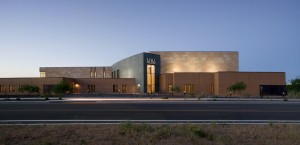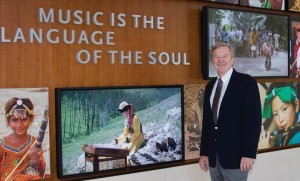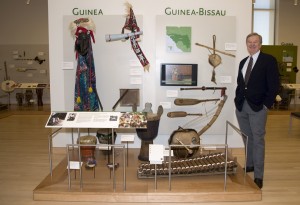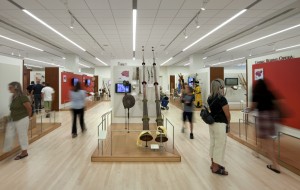By Cheryl Cranick, Honors Program

In the desert of Phoenix, Ariz., is a sprawling $250 million, 200,000-square-foot facility that blends into the arid background. But inside the walls is a collection of instruments that brings to life the world’s music. The Musical Instrument Museum (MIM), led by UConn Honors alumnus Dr. Bill DeWalt ’69, ’76, is not just a museum that displays devices for sound. MIM has a deeper mission: to create an all-encompassing sensory journey around the globe. It promises to be “the most extraordinary museum you’ll ever hear.”
DeWalt holds both his undergraduate Honors degree and Ph.D. in anthropology from the University of Connecticut. At UConn he gained not just a foundation in his subject area but also the ability to be a lifelong student, he said. From his university education, “I learned how to learn.” Since leaving Storrs, DeWalt has lived and worked all over the world. He has been an educator, administrator, consultant, and fundraiser. But at the core of this diverse career is his central focus on cultural anthropology and his deep-rooted commitment to understanding cultures.

In 2007, nearing the completion of a major expansion at the Carnegie Museum of Natural History in Pittsburgh as the institution’s director, DeWalt contacted a headhunting agency with whom he had worked before. It happened to be the same agency tasked with finding MIM’s founding president and director. Two hours later, DeWalt received a call back from the agency chief. “He told me, ‘Bill, we have the perfect job for you’,” remarked DeWalt. It was the agency’s hiring professional who saw the potential in DeWalt’s background before DeWalt even saw it himself.
DeWalt was not an expert in music or musical instruments when he took the helm of MIM, an argument he made to the agency chief. But then he paused to listen as his own career was put into perspective: years in university classrooms as a professor, Fulbright lecturer, researcher, advisor for major organizations such as the World Bank, and leader of multimillion dollar projects at other institutions. “I’ve had students who’ve worked all over the world,” said DeWalt. “I have contacts all over the world. I know how to fundraise. I know how to get a team behind a vision,” he said. Suddenly the offer seemed to make sense.
The most unique of its kind

MIM is the innovation of its benefactor, former chairman and chief executive officer of Target Corporation, Bob Ulrich, a great lover of culture and museums who set out to create a unique experience. The concept of a musical instrument museum is not entirely new on the surface. “There are several really fine ones in Europe,” said DeWalt. “But the thing about them is that they display musical instruments primarily as art.” MIM is special because exhibits are not just there to look at—they are meant to be fully experienced. To date, more than 400,000 people have explored MIM. That number is particularly impressive considering opening day was just two years ago on April 24, 2010.
The museum offers roughly 350 exhibits; the number not only meets the goal of showcasing music from every country in the world but also surpasses the target by highlighting additional territories and subcultures globally and various genres of music in the United States. “I like to think of the Musical Instrument Museum as beginning a museum for which there was no template,” said DeWalt. MIM is “collecting, preserving, and protecting musical instruments and music for future generations,” he said, while also “celebrating the history and diversity of musical instruments.”

The displays are equipped with video screens synchronized with transmitters. Guests wear wireless headphones that allow them to see and hear the instruments when they approach each exhibit. Thousands of hours of footage of native musicians were edited down to short videos that convey music through two to five clips. “That gives you just enough sense about what kind of sound is created by those musical instruments and how those musical instruments are played by people in their cultural context,” said DeWalt. “So they’re not just objects hanging on a wall.”
Instruments can be found in the five major geographical galleries; the Artist Gallery, with loaned objects from musicians such as John Lennon, Carlos Santana, and Elvis Presley; the Experience Gallery, with a variety of instruments available for patrons to play and touch; the Mechanical Music Gallery, which has the museum’s most expensive item, a 1920s Belgian dance hall organ designed to replace human musicians; a visible Conservation Lab, where instruments are repaired; and the Special Exhibitions area, which features traveling displays. MIM is never standing still. “One of the things we want to do as a museum is to constantly evolve,” said DeWalt.

And then there’s “our acoustical gem of a Musical Theater,” he said. The intimate 300-seat space has showcased musical talents from around the world. This ranges from classically trained violinist Joshua Bell and pianist Jeremy Denk, to Sierra Leone’s Refugee All Stars. The latter is an unlikely group of African artists that fled rebel violence, found strength in others at refugee camps, and became an international musical voice for their country.
“In spite of all these things that divide us—race, culture, ethnicity, religion—there’s something that unites us,” said DeWalt. “That is this need to create music and create musical instruments as amplifiers of human emotions.” From ancient Chinese drums to makeshift oilcan guitars, if a device is created by a culture to express melody, it is worthy of a place at MIM. “It’s people taking whatever is in their environment and making it into something that amplifies sound,” said DeWalt.
“If I said to you right now, ‘How many people here like music?’…Everybody likes music of some sort,” said DeWalt. “What I say is, ‘Have we got a museum for you.’ Whatever kind of music you like, you’re going to find it at MIM…and a lot more, because there is music here you have never heard before.”
Learn more about the Musical Instrument Museum
Return to the Spring 2012 issue of the Honors Alumni eNewsletter